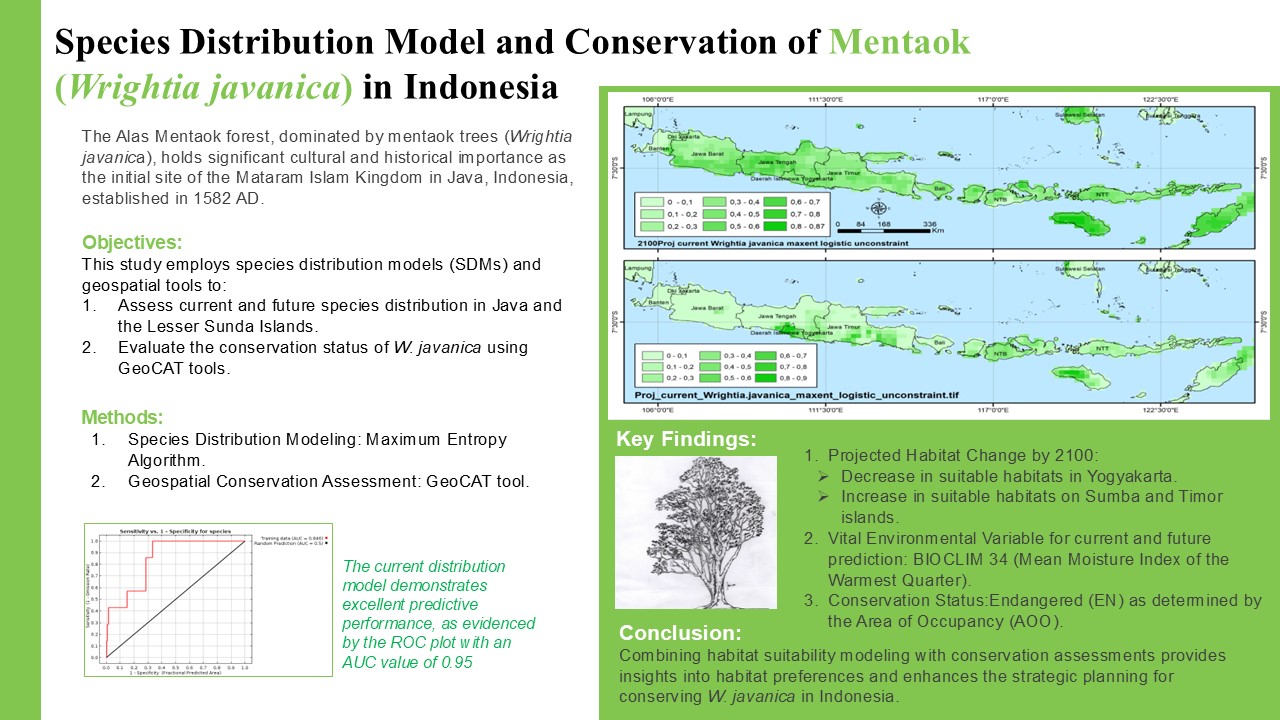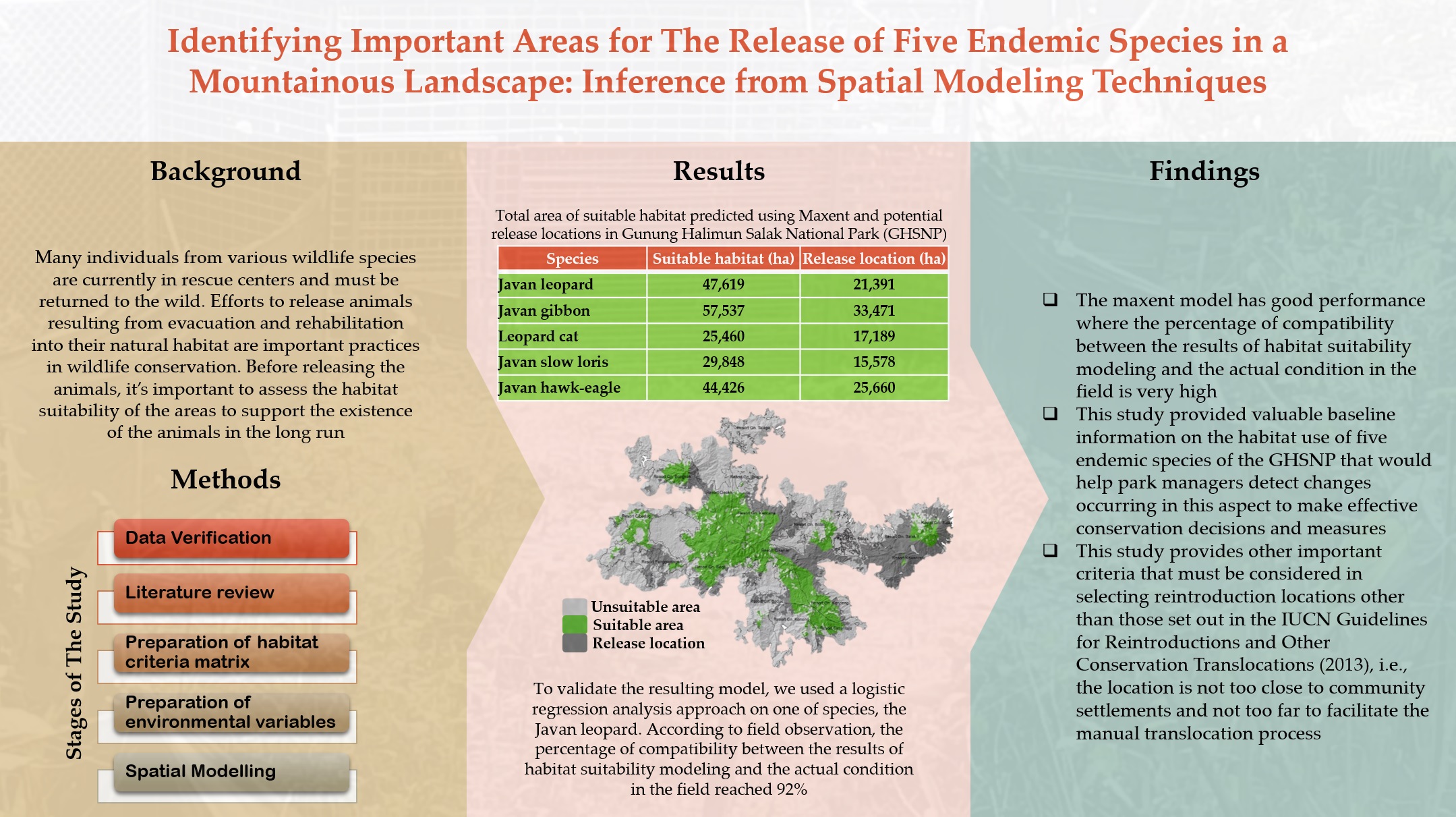Species Distribution Model and Conservation of Mentaok (Wrightia javanica) in Indonesia
Abstract
The Alas Mentaok was a forest dominated by the mentaok tree (Wrightia javanica) that once existed in Yogyakarta, Java Island, Indonesia. This forest has cultural and historical value, as it is believed to be the first location to establish the Mataram Islam Kingdom in Java in 1582 AD. This study utilized species distribution models (SDMs) to investigate the species distribution pattern and assess its latest conservation status in Java and the Lesser Sunda Islands, Indonesia. The methodology used involved collecting occurrence and environmental data of W. javanica, conducting species distribution modeling using the maximum entropy algorithm, evaluating the model's accuracy, and performing an independent assessment of the area of occupancy (AOO) and extensive occurrence (EOO) using the geospatial conservation assessment tool (GeoCAT). While the number of suitable habitat areas for W. javanica in Yogyakarta is projected to decrease by 2100, the islands of Sumba and Timor are anticipated to experience an increase in the suitable habitat areas for the species during the same year. The analysis of BIOCLIM 34 indicates the mean moisture index of the warmest quarter plays a vital role in the current and future projections. AOO calculation in GeoCAT places this species in the endangered (EN) category, particularly within our regions of interest in Java and the Lesser Sunda Islands. Overall, a full assessment combining a habitat suitability model with current conservation status information would provide a more comprehensive understanding of mentaok's habitat preferences and current conservation status in Indonesia.
References
Abolmaali, S. M. R., Tarkesh, M., & Bashari, H. (2018). MaxEnt modeling for predicting suitable habitats and identifying the effects of climate change on a threatened species, Daphne mucronata, in central Iran. Ecological Informatics, 43, 116–123. https://doi.org/10.1016/j.ecoinf.2017.10.002
Afrianto, W. F. (2021). The potential distribution prediction of the invasive alien species Acacia decurrens Wild., in Indonesia. International Journal of Applied Biology, 5(2), 74–84. https://doi.org/10.20956/ijab.v5i2.17949
Akashi, N. U. (2023, November 20). Kisah pembukaan Alas Mentaok, cikal bakal Kerajaan Mataram Islam. DetikJogja. https://www.detik.com/jogja/budaya/d-7047391/kisah-pembukaan-alas-mentaok-cikal-bakal-kerajaan-mataram-islam
Bachman, S., Moat, J., Hill, A., de la Torre, J., & Scott, B. (2011). Supporting red list threat assessments with GeoCAT: Geospatial conservation assessment tool. ZooKeys, 150, 117–126. https://doi.org/10.3897/zookeys.150.2109
Bali Botanic Gardens. (2023). The garden book of Bali Botanic Gardens. Directorate of Scientific Collection Management–National Research and Innovation Agency (BRIN).
[BCCVL]. Biodiversity and Climate Change Virtual Laboratory. (2021). Maxent. Biodiversity and Climate Change Virtual Laboratory. Retieved from https://support.bccvl.org.au/support/solutions/articles/6000083216-maxent
Booth, T. H. (2018). Species distribution modelling tools and databases to assist managing forests under climate change. Forest Ecology and Management, 430, 196–203. https://doi.org/10.1016/j.foreco.2018.08.019
[BPS] Badan Pusat Statistik Sumba Timur. (2023). Sumba Timur in figures. Retrieved from https://sumbatimurkab.bps.go.id/id/publication/2023/02/28/fec486917d92805ce933a979/sumba-timur-regency-in-figures-2023.html
[BPS] Badan Pusat Statistik Yogyakarta. (2023). Yogyakarta Municipality in figures. Retrieved from https://jogjakota.bps.go.id/id/publication/2023/02/28/9510c8b16be475ce64f99471/kota-yogyakarta-dalam-angka-2023.html
Cipta, H., Nugroho, W. D., Tazuru, S., & Sugiyama, J. (2022). Identification of the wood species in the wooden sheath of Indonesian kris by synchrotron X-ray microtomography. Journal of Wood Science, 68(1), 65. https://doi.org/10.1186/s10086-022-02072-z
Cravero, A., Sepúlveda, S., & Muñoz, L. (2020). Big data architectures for the climate change analysis: A systematic mapping study. IEEE Latin America Transactions, 18(10), 1793–1806. https://doi.org/10.1109/TLA.2020.9387671
Crego, R. D., Nielsen, C. K., & Didier, K. A. (2014). Climate change and conservation implications for wet meadows in dry Patagonia. Environmental Conservation, 41(2), 122–131. https://doi.org/10.1017/S037689291300026X
EcoCommons. (2022). EcoCommons: World-first collaborative commons. Retrieved from https://auth.test.ecocommons.org.au
Elith, J., Phillips, S. J., Hastie, T., Dudík, M., Chee, Y. E., & Yates, C. J. (2011). A statistical explanation of MaxEnt for ecologists. Diversity and Distributions, 17(1), 43–57. https://doi.org/10.1111/j.1472-4642.2010.00725.x
Faida, L. R. W., & Marhaento, H. (2019). Extinction risk analysis of Anthocephalus macrophyllus in Gunungsewu Karst Area, Southern Java, Indonesia. Biodiversitas, 20(7), 1 1897–19035. https://doi.org/10.13057/biodiv/d200715
Faida, L. R. W., Sunarto, Sutikno, & Fandeli, C. (2018). Gunung Sewu: Menguak jejak sejarah flora, merekonstruksi kawasan karst. Yogyakarta: UGM Press.
Hakim, A., Jamaluddin, J., Idrus, S. W. A., & Ramandha, M. E. P. (2020). The Use of SASAMBO Culture in Learning Natural Product Chemistry to Support Traditional Health Tourism in Lombok and Sumbawa Islands. Jurnal Penelitian Pendidikan IPA, 6(2), 178–183. https://doi.org/10.29303/jppipa.v6i2.435
Hakim, L., & Yuliah, Y. (2018). Peran B2P2BPTH Yogyakarta dalam pelestarian jenis-jenis khas Daerah Istimewa Yogyakarta. Prosiding SNPBS (Seminar Nasional Pendidikan Biologi dan Saintek), 2018, 329–337.
Hallgren, W., Beaumont, L., Bowness, A., Chambers, L., Graham, E., Holewa, H., Laffan, S., Mackey, B., Nix, H., Price, J., Vanderwal, J., Warren, R., & Weis, G. (2016). The biodiversity and climate change virtual laboratory: Where ecology meets big data. Environmental Modelling & Software, 76, 182–186. https://doi.org/10.1016/j.envsoft.2015.10.025
Hallgren, W., Santana, F., Low Choy, S., Rehn, J., & Mackey, B. (2017). Sensitivity analysis to configuration option settings in a selection of species distribution modelling algorithms. In G. Syme, D. Hatton MacDonald, B. Fulton, & J. Piantadosi. (Eds.), MODSIM2017, the 22nd international congress on modelling and simulation (pp. 50–56). Modelling and Simulation Society of Australia and New Zealand Inc. (MSSANZ). https://doi.org/10.36334/modsim.2017.A1.Hallgren
Handayani, G. D., & Priyono, K. D. (2016). Evaluasi potensi kawasan Kotagede sebagai destinasi wisata berbasis warisan budaya (heritage tourism) Daerah Istimewa Yogyakarta [bachelor thesis]. Surakarta: Universitas Muhammadiyah Surakarta. Retrieved from https://eprints.ums.ac.id/47207/
[IPCC] Intergovernmental Panel on Climate Change. (2000). IPCC special report: Emissions scenarios. Cambridge University Press.
[IUCN] International Union for Conservation of Nature. (2012). IUCN red list categories and criteria. Version 3.1 (2nd ed.).
Kawamoto, S., Koyano, T., Kowithayakorn, T., Fujimoto, H., Okuyama, E., Hayashi, M., Komiyama, K., & Ishibashi, M. (2003). Wrightiamines A and B, two new cytotoxic pregnane alkaloids from Wrightia javanica. Chemical and Pharmaceutical Bulletin, 51(6), 737–739. https://doi.org/10.1248/cpb.51.737
Kew. (2023). GeoCAT–Geospatial conservation assessment tool. Kew-The Royal Botanics Garden. Retrieved from https://www.kew.org/science/our-science/projects/geocat-geospatial-conservation-assessment-tool
Kew Science. (2023). Wrightia javanica A.DC. Kew Science-Plants of the world online. Retrieved from http://powo.science.kew.org/taxon/urn:lsid:ipni.org:names:82855-1
Kisworo, D. (2022). Chemical and sensory properties of Palopo (local soft cheese) produced using natural additive as milk coagulant. AJARCDE (Asian Journal of Applied Research for Community Development and Empowerment), 6(2), 9–14. https://doi.org/10.29165/ajarcde.v6i2.93
Krause, C., & Pennington, D. (2012). Strategic decisions in conservation: Using species distribution modeling to match ecological requirements to available habitat. In J., Maschinski, K. E. Haskins, & P. H. Raven (Eds.), Plant reintroduction in a changing climate (pp. 131–153). Island Press/Center for Resource Economics. https://doi.org/10.5822/978-1-61091-183-2_8
Kriticos, D. J., Webber, B. L., Leriche, A., Ota, N., Macadam, I., Bathols, J., & Scott, J. K. (2012). CliMond: Global high‐resolution historical and future scenario climate surfaces for bioclimatic modelling. Methods in Ecology and Evolution, 3(1), 53–64. https://doi.org/10.1111/j.2041-210X.2011.00134.x
Lestari, A. (2018). Persebaran mentaok (Wrightia javanica) di Kecamatan Kotagede Yogyakarta [diploma thesis]. Yogyakarta: Universitas Gadjah Mada. Retrieved from https://etd.repository.ugm.ac.id/home/detail_pencarian/161606
Low Choy, S., & Huijbers, C. (2017). Experimenting with modelling via a virtual laboratory: Evaluating pseudo-absence strategies to refine a species distribution model. In G. Syme, D. Hatton MacDonald, B. Fulton, & J. Piantadosi (Eds.), MODSIM2017, the 22nd international congress on modelling and simulation (pp. 943–949). Modelling and Simulation Society of Australia and New Zealand Inc. (MSSANZ). https://doi.org/10.36334/modsim.2017.G8.Lowchoy
Merow, C., Smith, M. J., & Silander, J. A. (2013). A practical guide to MaxEnt for modeling species’ distributions: What it does, and why inputs and settings matter. Ecography, 36(10), 1058–1069. https://doi.org/10.1111/j.1600-0587.2013.07872.x
Middleton, D. J. (2005). A revision of Wrightia (Apocynaceae: Apocynoideae) in Malesia. Harvard Papers in Botany, 10, 161–182. https://doi.org/10.3100/1043-4534(2005)10[161:AROWAA]2.0.CO;2
Mota-Vargas, C., & Rojas-Soto, O. R. (2012). The importance of defining the geographic distribution of species for conservation: The case of the bearded wood-partridge. Journal for Nature Conservation, 20(1), 10–17. https://doi.org/10.1016/j.jnc.2011.07.002
Mulu, M., Ntelok, Z. R. E., Sii, P., & Mulu, H. (2020). Ethnobotanical knowledge and conservation practices of indigenous people of Mbeliling forest area, Indonesia. Biodiversitas Journal of Biological Diversity, 21(5), 18611873. https://doi.org/10.13057/biodiv/d210512
Rahman, A. A., Mohamed, M., Tokiman, L., & Mohd Sanget, M.-S. (2019). Species distribution modelling to assist biodiversity and conservation management in Malaysia. IOP Conference Series: Earth and Environmental Science, 269(1), 012041. https://doi.org/10.1088/1755-1315/269/1/012041
Richmond, S., & Huijbers, C. (2019). Virtual laboratories for biodiversity modelling: An Australian perspective. Biodiversity Information Science and Standards, 3, e37440. https://doi.org/10.3897/biss.3.37440
Saputra, M. H., & Lee, H. S. (2021). Evaluation of climate change impacts on the potential distribution of Styrax sumatrana in North Sumatra, Indonesia. Sustainability, 13(2), 462. https://doi.org/10.3390/su13020462
Saputra, M. H., Sutomo, Humaida, N., & Hadiyan, Y. (2023). Smart farming: Modeling distribution of Xanthomonas campestris pv. oryzae as a leaf blight-causing bacteria in rice plants. IOP Conference Series: Earth and Environmental Science, 1133(1), 012026. https://doi.org/10.1088/1755-1315/1133/1/012026
Soilhi, Z., Sayari, N., Benalouache, N., & Mekki, M. (2022). Predicting current and future distributions of Mentha pulegium L. in Tunisia under climate change conditions, using the MaxEnt model. Ecological Informatics, 68, 101533. https://doi.org/10.1016/j.ecoinf.2021.101533
Sudrajat, A. (2012). Optimalisasi area sekitar makam keluarga Pakualaman menurut tinjauan jenis dan arsitektur pohon di Bukit Bangkel, Yogyakarta [bachelor thesis]. Yogyakarta: Gadjah Mada University. Retrieced from https://etd.repository.ugm.ac.id/home/detail_pencarian_downloadfiles/271960
Susilo, A. A., & Asmara, Y. (2020). Sultan Agung Hanyakrakusuma dan eksistensi Kesultanan Mataram. Diakronika, 20(2), 114–127. https://doi.org/10.24036/diakronika/vol20-iss2/133
Sutomo, Atmaja, M. B., Darma, I. D. P., Iryadi, R., Hani, A., Wijaya, I. M. S., Widyartha, M. M., & Etten, E. van. (2023a). An update on the habitat suitability model of Dacrycarpus imbricatus (Blume) de Laub. and its conservation status in Bali, Indonesia. Journal of Tropical Biodiversity and Biotechnology, 8(1), jtbb74578. https://doi.org/10.22146/jtbb.74578
Sutomo, Iryadi, R., & Kurniawati, F. (2021a). Habitat suitability model of Agarwood in a changing climate. IOP Conference Series: Earth and Environmental Science, 724(1), 012022. https://doi.org/10.1088/1755-1315/724/1/012022
Sutomo, S., & van Etten, E. (2017). Species distribution model of invasive alien species Acacia nilotica for central-eastern Indonesia using Biodiversity Climate Change Virtual Laboratory (BCCVL). International Journal of Tropical Drylands, 1(1), 36–42. https://doi.org/10.13057/tropdrylands/t010106
Sutomo, Saputra, M. H., & Humaida, N. (2023b). Potential future distribution of Scirpophaga incertulas (Walker) in Indonesia. IOP Conference Series: Earth and Environmental Science, 1182(1), 012007. https://doi.org/10.1088/1755-1315/1182/1/012007
Sutomo, Yulia, E., & Iryadi, R. (2021b). Kirinyuh (Chromolaena odorata): Species distribution modeling and the potential use of fungal pathogens for its eradication. IOP Conference Series: Earth and Environmental Science, 762(1), 012023. https://doi.org/10.1088/1755-1315/762/1/012023
Sutomo, Yuni, L. P. E. K., Iryadi, R., & Etten, E. van. (2023c). Habitat suitability modeling for jalak bali (Leucopsar rothschildi) in East Java, Bali, and Lombok: A potential sites for its ex-situ conservation. AIP Conference Proceedings, 2606(1), 050005. https://doi.org/10.1063/5.0118658
Swan, M., Le Pla, M., Di Stefano, J., Pascoe, J., & Penman, T. D. (2021). Species distribution models for conservation planning in fire‐prone landscapes. Biodiversity and Conservation, 30(4), 1119–1136. https://doi.org/10.1007/s10531-021-02136-4
Syahbudin, A., Adriyanti, D. T., Mulyana, B., Meinata, A., Phenomenon, S. P., Hanindita, A. S. H., Syaufina, R. L., Yudhistira, R., Arifriana, R., Makkarennu, Osozawa, K., & Ninomiya, I. (2018). Urban trees in the cities of Matsuyama (Japan) and Yogyakarta (Indonesia): Tree species diversity, design, and culture. IOP Conference Series: Earth and Environmental Science, 203(1), 012013. https://doi.org/10.1088/1755-1315/203/1/012013
Vaganov, A. V., Zaikov, V. F., Krotova, O. S., Musokhranov, A. I., Pokalyakin, Z. V., & Khvorova, L. A. (2022). Modeling a potential plant habitat using machine learning methods. Izvestiya of Altai State University, 4(126), 85–92. https://doi.org/10.14258/izvasu(2022)4-13
van Sam, H., Nanthavong, K., & Kessler, P. J. A. (2004). Trees of Laos and Vietnam: A field guide to 100 economically or ecologically important species. Blumea- Biodiversity, Evolution and Biogeography of Plants, 49(2), 201–349. https://doi.org/10.3767/000651904X484298
Wisz, M. S., Hijmans, R. J., Li, J., Peterson, A. T., Graham, C. H., Guisan, A., & Group, N. P. S. D. W. (2008). Effects of sample size on the performance of species distribution models. Diversity and Distributions, 14(5), 763–773. https://doi.org/10.1111/j.1472-4642.2008.00482.x
Yamin, M., Burhanudin, Jamaluddin, & Nasruddin. (2018). Pengobatan dan obat tradisional suku Sasak di Lombok. Jurnal Biologi Tropis, 18(1), 1–12. https://doi.org/10.29303/jbt.v18i1.560
Authors

This work is licensed under a Creative Commons Attribution 4.0 International License.
Jurnal Manajemen Hutan Tropika is an open access journal which means that all contents is freely available without charge to the user or his/her institution. Users are allowed to read, download, copy, distribute, print, search, or link to the full texts of the articles in this journal without asking prior permission from the publisher or the author. This is in accordance with the Budapest Open Access Initiative (BOAI) definition of open access.






